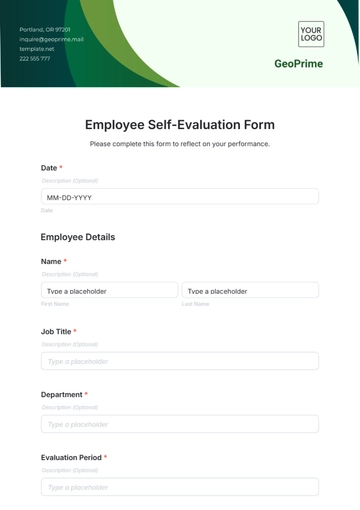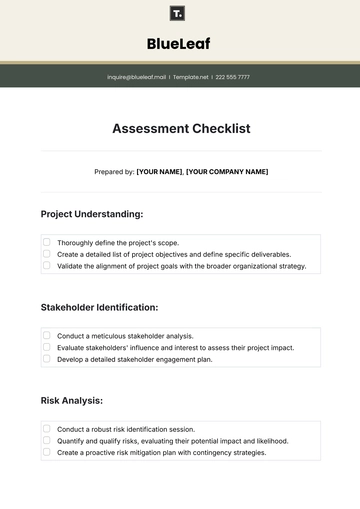Free Compliance Risk Assessment Advertising Report

1. Purpose
The primary purpose of this report is to conduct a thorough and comprehensive analysis of the compliance risks associated with the advertising activities of [Your Company Name]. In the ever-evolving landscape of advertising, where regulations and standards are continually updated, it is crucial for our company to stay ahead of potential compliance pitfalls. This report aims to proactively identify, assess, and strategize against risks that could arise from regulatory non-compliance.
Our advertising practices encompass a wide range of activities, from digital marketing to traditional media advertising. Each of these areas brings its unique set of compliance challenges, be it in data protection, consumer rights, or advertising standards. The goal is to create a detailed map of these risks, understanding their nature, the likelihood of occurrence, and their potential impact on our business. This understanding is crucial in developing targeted mitigation strategies that not only address current compliance requirements but also anticipate future regulatory changes.
Furthermore, this report serves as a foundation for establishing a robust compliance framework within [Your Company Name]. By integrating the insights gained from this analysis into our daily operations, we can ensure that our advertising strategies not only drive business growth but also align with legal and ethical standards. This approach is integral to maintaining our reputation as a responsible and trustworthy company in the eyes of our clients, customers, and regulatory bodies. In essence, this report is not just a compliance document; it is a strategic tool that underpins the sustainable and ethical growth of [Your Company Name] in the competitive world of advertising.
2. Overview of Compliance Risks
Key Compliance Areas
In the realm of advertising, [Your Company Name] operates under various regulatory frameworks that govern different aspects of our business activities. It is vital to recognize and understand the various compliance risks in these key areas:
1. Data Protection and Privacy (GDPR, CCPA): These regulations govern how we collect, use, store, and share personal data. Non-compliance could lead to significant fines and loss of consumer trust.
2. Advertising Standards (FTC guidelines, local advertising laws): This includes compliance with truth-in-advertising standards, ensuring that all claims are substantiated and not misleading.
3. Intellectual Property Rights: Protecting the intellectual property rights of others, and ensuring our advertising content does not infringe upon these rights, is crucial to avoid legal disputes.
4. Consumer Protection Laws: These laws ensure that consumers are treated fairly and are not subjected to deceptive or unfair business practices.
Risk Identification Methodology
To identify these risks effectively, [Your Company Name] employs a comprehensive methodology:
Stakeholder Interviews: Engaging with different stakeholders, including marketing teams, legal advisors, and external partners, provides insights into potential risk areas from various perspectives.
Industry Best Practices: Benchmarking against industry best practices helps us to understand standard compliance measures and where we stand in comparison.
Regulatory Requirements Analysis: Regular analysis of existing and upcoming regulatory requirements ensures we are always up-to-date with compliance obligations.
Compliance Risk Table
Compliance Area | Identified Risks | Potential Impact | Mitigation Strategies |
Data Protection and Privacy | Non-adherence to GDPR/CCPA guidelines | Legal fines, reputational damage | Regular data protection training, GDPR/CCPA compliance audits |
Advertising Standards | Violation of FTC guidelines, local laws | Legal penalties, loss of credibility | Regular data protection training, GDPR/CCPA compliance audits |
Intellectual Property Rights | Violation of FTC guidelines, local laws | Legal disputes, financial liabilities | Regular IP rights training, use of licensed or original content |
Consumer Protection Laws | Non-compliance with consumer rights | Consumer distrust, legal challenges | Consumer rights awareness programs, compliance checks |
Through this comprehensive overview of compliance risks, [Your Company Name] is equipped to navigate the complex landscape of advertising regulations. Understanding and mitigating these risks are essential in maintaining our company's integrity and reputation in the marketplace.
3. Detailed Risk Analysis
In this crucial section, we delve deep into the specifics of the compliance risks that [Your Company Name] faces in its advertising operations. By dissecting each risk into its core components, we aim to create a transparent and thorough understanding of the potential challenges and their implications. This detailed risk analysis is instrumental in guiding our strategic decisions and prioritizing our compliance efforts.
For each identified risk, we assess four key elements: the risk category, the specific risk within that category, the potential impact of the risk, and its likelihood of occurrence. Additionally, we evaluate the current controls that [Your Company Name] has in place to mitigate these risks. This multi-faceted approach ensures a comprehensive understanding and facilitates more effective risk management.
We categorize the risks into three primary areas: Data Privacy, Advertising Standards, and Intellectual Property. Each category encompasses specific risks that could significantly impact our business operations and reputation. For instance, non-compliance with GDPR under Data Privacy not only carries legal penalties but also risks eroding customer trust, a critical asset in the advertising industry. Similarly, risks like misleading advertisements and copyright infringement, while varying in their nature and likelihood, can lead to serious legal and financial consequences.
The following table presents a detailed breakdown of these risks, offering a clear view of the current landscape and our preparedness to handle these challenges:
Risk Category | Specific Risk | Potential Impact | Likelihood | Current Controls |
Data Privacy | Non-compliance with GDPR | Legal penalties, loss of customer trust | High | GDPR Compliance Program |
Advertising Standards | Misleading Advertisements | Fines, reputational damage | Medium | Marketing Review Process |
Intellectual Property | Copyright Infringement | Legal disputes, financial liabilities | Low | IP Rights Training |
This detailed risk analysis is not just a static snapshot; it is a dynamic tool that [Your Company Name] will continually refine and update to align with the ever-changing landscape of advertising regulations and business practices.
4. Mitigation Strategies
In response to the risks identified in our Detailed Risk Analysis, [Your Company Name] has developed a set of targeted mitigation strategies. These strategies are designed to not only address the immediate risks but also to reinforce our long-term commitment to compliance and ethical business practices.
1. Advanced Data Encryption: To safeguard sensitive customer data, we will implement cutting-edge encryption technology across all our digital platforms. This includes encrypting data at rest and in transit, ensuring that customer information remains secure from unauthorized access.
2. Regular Data Privacy Training for Employees: Recognizing that human error can often lead to data breaches, we will conduct regular training sessions for our employees. These sessions will focus on best practices in data handling, awareness of potential data risks, and the importance of GDPR compliance. By empowering our employees with knowledge and tools, we aim to create a culture of data security within the organization.
3. Robust Review Process: To ensure that all our advertising materials are in line with FTC guidelines and local advertising laws, we will establish a stringent review process. This process will involve multiple checks for accuracy, truthfulness, and compliance with legal standards before any advertising material is published or disseminated.
4. Ongoing Legal and Compliance Training: Continuous education programs for our marketing and legal teams will be implemented to keep them abreast of the latest advertising standards and regulations. This proactive approach will help prevent any unintentional violations of advertising laws.
5. Regular Audits: Intellectual Property (IP) audits will be conducted regularly to ensure that all content used in our advertising is either properly licensed or originally created. These audits will help identify potential IP infringements before they become legal issues.
6. Staff Education Programs: To prevent unintentional copyright infringements, we will introduce comprehensive education programs for our staff. These programs will cover the basics of IP rights, the importance of using licensed or original content, and the procedures to follow when sourcing material for advertising.
By implementing these strategies, [Your Company Name] aims to significantly reduce the risk of non-compliance in our advertising practices. These measures not only protect the company from potential legal repercussions but also enhance our reputation as a responsible and trustworthy advertiser in the industry.
5. Compliance Monitoring and Reporting
To ensure that [Your Company Name] consistently meets and exceeds compliance standards in its advertising practices, a robust system for monitoring and reporting is imperative. This system is designed to not only detect and address compliance issues but also to foster a culture of continuous improvement within the organization.
Regular Compliance Audits
Bi-annual Audits: We will conduct comprehensive compliance audits twice a year. These audits are aimed at thoroughly assessing our adherence to various regulations, including GDPR, FTC guidelines, and other relevant advertising and data protection laws. These audits will be conducted by an internal compliance team, with occasional assistance from external experts to provide an unbiased perspective.
Audit Scope and Focus: The audits will cover all aspects of our advertising operations, from data collection and processing to the execution of advertising campaigns. Key focus areas will include data privacy practices, accuracy of advertising content, intellectual property usage, and adherence to consumer protection laws.
Actionable Insights: Post-audit, a detailed report will be generated, highlighting areas of compliance and non-compliance, and providing actionable recommendations for improvement.
Reporting Mechanism
Compliance Issue Reporting System: We will implement a structured system for reporting compliance issues. This system will be accessible to all employees, enabling them to report any suspected non-compliance incidents anonymously.
Corrective Action Plan: Upon receiving a report of non-compliance, a thorough investigation will be conducted. Based on the findings, a corrective action plan will be developed and implemented promptly to address the identified issues.
Continuous Improvement
Updating Compliance Strategies: Insights gained from regular audits and compliance reports will be utilized to continuously update and improve our compliance strategies. This approach ensures that our practices remain effective and relevant in the face of changing regulations and industry standards.
Training and Awareness Programs: Based on audit findings and updates in compliance regulations, we will regularly update our training and awareness programs. This ensures that all employees are knowledgeable about the latest compliance requirements and understand their role in maintaining these standards.
Through these measures, [Your Company Name] aims to maintain a high standard of compliance in all its advertising activities. Our approach to compliance monitoring and reporting demonstrates our commitment to operating with integrity and upholding our responsibility to clients, consumers, and regulatory bodies.
6. Conclusion
The thorough analysis and strategic insights provided in this Compliance Risk Assessment Advertising Report are a testament to [Your Company Name]'s unwavering commitment to upholding the highest standards of regulatory compliance in the advertising industry. This report goes beyond mere regulatory adherence; it reflects our deep understanding of the critical role that compliance plays in the sustainability and success of our business. By proactively identifying and addressing the various risks outlined, [Your Company Name] not only fortifies its reputation as a responsible and ethical player in the market but also cements the trust and confidence of our clients and customers.
Our commitment to compliance is not just a legal obligation but a core value that drives our business decisions and practices. It is a commitment that extends to every aspect of our operations, from the boardroom to individual team members. By continuously refining our compliance strategies and staying ahead of regulatory changes, we ensure that our advertising campaigns are not only innovative and impactful but also adhere to the highest standards of legal and ethical conduct. This proactive approach to compliance positions [Your Company Name] as a leader in responsible advertising, setting a benchmark for excellence and integrity in a competitive and rapidly evolving industry.
7. Appendices
Appendix A: Full Legal Compliance Checklist
Appendix B: Audit Schedule and Reports
Appendix C: Training Materials and Records
This report should be used as a living document, regularly updated to reflect changes in the regulatory landscape and internal company processes. It is a vital tool in [Your Company Name]'s ongoing efforts to conduct business ethically, responsibly, and in compliance with all relevant laws and regulations.
- 100% Customizable, free editor
- Access 1 Million+ Templates, photo’s & graphics
- Download or share as a template
- Click and replace photos, graphics, text, backgrounds
- Resize, crop, AI write & more
- Access advanced editor
Introducing the Compliance Risk Assessment Advertising Report Template by Template.net, meticulously crafted to streamline and fortify your risk assessment processes. This comprehensive document serves as a robust framework for evaluating and mitigating compliance risks in advertising endeavors. Elevate your regulatory adherence with this expertly designed template.





























